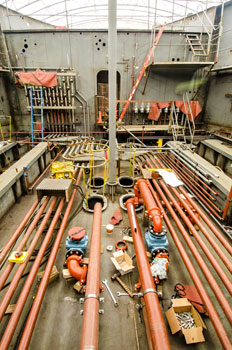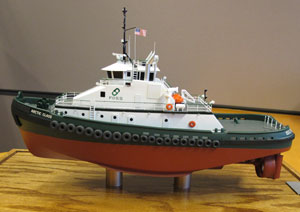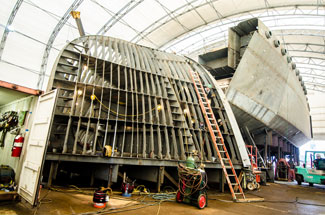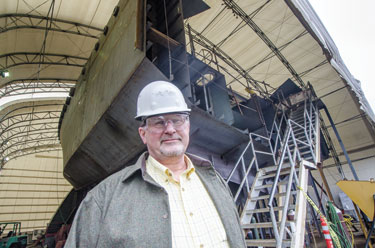The people involved in the development of Foss Maritime’s Arctic-class tugs don’t expect the company’s three new 130-foot ocean-towing boats to be revolutionary, but they do expect them to be among the best in the world.
Foss has tried to draw on some of the best thinking on tugboat design and operations — much of it from its own in-house expertise — to create a tug that can operate safely and efficiently in even the most extreme settings, notably the Arctic.
“We’ve integrated design features to make it able to go anywhere in the world,” said Dan Cole, Foss project manager.
The first boat is due for delivery in December. The next two are expected to be ready in December 2015 and December 2016. These will be powerful tugs, with bollard pull of over 100 metric tons. Rated at 7,268 hp, the boats will be powered by dual Tier 2 Caterpillar C280-8 diesels.
Foss — which expects the boats to support the petroleum industry’s search for oil and gas around the world, and under the Arctic Ocean in particular — has a great deal of experience in the far north.
 |
|
The engine room under construction. The tugs will be powered by two Cat C280-8 Tier 2 diesels generating a total of 7,268 hp. |
“Foss has a longstanding commitment to Alaska and the Arctic,” said Mike Magill, Foss vice president of technical services. “There hasn’t been any marine work up in the Arctic that Foss hasn’t been involved in.”
Foss is building these boats largely in response to the opening of the Arctic to offshore oil and gas development. “Most people agree the Arctic will provide some unique opportunities,” Magill said.
For example, the boats could be used to haul barges that carry the equipment needed to cope with a spill. “We are their protection for blowouts,” said James Daley, Foss director of operations, global services.
The major oil companies decide which boats it wants to support its operations. And bollard pull will be one of the key criteria. High bollard pull is “the ticket you need to play,” said Jay Edgar, president of Glosten Associates, the Seattle naval architecture and marine engineering firm that designed the Foss Arctic-class tugs.
While raw power is crucial, the boats must also be able to operate safely and reliably in some of the most challenging and environmentally sensitive areas of the planet. That requires robust structures that can withstand impacts with ice.
The Foss tugs have been certified by the American Bureau of Shipping as meeting the standards of Ice Class D0. The power train — including gearboxes, shafting and propellers — has also been beefed up. The diameter of the shafts and the thickness of the propellers have both been increased to withstand the shocks of ice operations.
Foss also asked Nautican to provide a custom design for the integrated propeller, nozzle and high efficiency triple-rudder system. The nozzle is attached to a head box that extends up into the hull. The idea was to create a solid connection between the hull and the nozzle, so that when ice strikes the nozzle and propeller, the forces will not stress the propeller shaft.
The integrated Nautican system, which includes pre-swirl stators, contributes to the power and efficiency of the propulsion system. The stators deflect the flow of water as it enters the props in a way that improves the way the props bite into the water.
Douglas M. Wolff, Foss director of engineering, said the Nautican system contributes to higher bollard pull, while improving fuel economy. The system adds about a quarter knot to the boat’s speed, while improving fuel efficiency at all speed ranges.
The boats will have a multitude of features to help them cope with extreme cold. Accumulation of ice on a vessel can pose a threat to its stability. Clearing that ice can be a difficult, exhausting task. To counter ice buildup, the inner sides of the bulwarks have been enclosed with vertical steel plates, creating flat surfaces.
“It gives you less surface area for ice to collect and it’s easier to clear,” said Cole, the project manager.
The sea chests, which admit the water for cooling the engines, have to be kept ice-free. They have been equipped with heaters to prevent ice from clogging them.
For a vessel operating in the far north, the issues of structural integrity and systems reliability are closely related to safety and environmental protection. A vessel that loses propulsion or begins taking on water as a result of ice damage becomes a danger to its crew and to the environment. The pristine state of the Arctic means that even in the course of ordinary operations, no discharges are acceptable. The Foss boats were designed with that principle in mind.
 |
|
John Gormley |
|
A model of the 130-foot tug designed by Glosten Associates. |
Edgar, president of Glosten Associates, explained that there will be no discharges of cooling water from the engines. Instead the boats will have a keel-cooling system employing hull-mounted coolers and heat exchangers. Fresh water circulating in a closed loop will take heat from the engines and then transfer it via a heat exchanger to seawater from the sea chests. The seawater that takes away the engines’ heat will never actually enter the engine room.
“You don’t bring cooling water into the vessel,” Edgar said. “You’re only using heat exchangers. There’s no intake or discharge of cooling water.”
The engine room is designed to stay dry. Rather than using packing, which must stay wet, to seal the openings where the shafts exit the hull, the boats will have mechanical seals to block the ingress of water.
“The bilge of the boat should be dry,” Magill said.
The boats will not have ballast tanks, thereby eliminating ballast water discharges and the danger of introducing invasive species. In the absence of ballast tanks, the tugs will transfer fuel from one tank to another in order to maintain proper trim.
Foss and Glosten went to great lengths to reduce the chances of a fuel spill by designing a cascading overflow system. It comprises two series — one on the port side and one on the starboard — of interconnected fuel tanks protected by an overflow tank. As one tank fills to the top, it overflows to the next, and so on through the series. This means that all the storage tanks can be filled right to the top without spillage. The overflow tank, which is normally kept empty, will capture any fuel if the last of the tanks is accidentally overfilled. Even if the overflow tank becomes full, there is another line of defense: a containment on deck that would capture oil and prevent it from going over the side.
“It’s a pretty unusual system,” Edgar said. “The consequence of an oil spill is so high, it warranted putting in a more complex system.”
The worst kind of spill, of course, would occur if ice or some other object breached the hull and the fuel tanks began to leak, or in the worst case, the tug actually began to sink. The design aims to minimize those dangers. Along its sides, two layers of steel create protective void spaces. Along the hull’s bottom, the space between an inner and outer layer of steel is used for fuel storage.
“Flooding of the engine room is typically the way tugs are lost. If you flood the engine room, the potential for loss of the vessel is very high,” Edgar said.
 |
|
Brian Gauvin |
|
A bow module being readied for plate. Designed as zero-discharge boats, the tugs will have no ballast tanks. The hull sides will have two layers of steel, creating void spaces to protect against side impacts. |
When operating in ice, the greatest risk of damage is to the sides of the hull. The void created by the double layer of steel along the sides serves to protect against a spill and loss of the tug through flooding. The double layer along the bottom protects against flooding of the engine room.
“With bottom damage, you wouldn’t lose the vessel, but you might spill fuel. On the sides, you have protection against both a fuel spill and loss of the vessel,” Edgar said.
At the heart of the boat’s design is the towing winch. “We designed the boat around the towing mission,” Edgar said.
Foss chose a diesel-driven Markey double-drum TDSD-40 with a line pull of 91 metric tons and braking power of 230 metric tons. The drums are side by side with identical sets of towing lines — 3,000 feet of 2.25-inch wire. Because the wire is underwound, the towing line lies close to the deck as it spools off the drum and goes off the stern on rollers. This arrangement helps to keep the center of gravity low, enhancing the stability of the boats.
Scott Kreis, Markey Machinery’s vice president of sales, called the towing arrangements “a conventional approach with some unconventional features.”
The winch operates in conjunction with tow pins and shark jaws at the stern. The towing bridle consists of 3-inch links of chain. “These things are large and heavy and can be dangerous to handle,” Kreis said.
The shark jaws are used to safely secure the towing gear. And the underwound wire passing close to the deck keeps the handling forces low and allows the shark jaws embedded in the deck to engage the gear. This arrangement allows for “handling the gear in as safe a manner as possible,” Kreis said.
While the winch is diesel-powered and chain driven, the boat is also equipped with an electric come-home drive that can be used to haul in the towing line.
“It would come in very slowly, but it would come in,” Kreis said. “It’s good insurance; it utilizes a different power source.”
For environmental reasons, Foss asked Markey to incorporate a small reservoir, or sump, that would capture any dripping lubricants and contain them within the frame of the winch.
The towing winch also features a water-cooled slip brake, a feature that Markey has used in its high-performance escort winches. The winch operator has the option of disengaging the band brake and engaging the slip brake. It can be set to allow for a bit of give in response to surges in the forces on the towline. Kreis said this feature would be particularly valuable when transiting confused seas and would reduce strain on the towing gear and the winch itself.
The ability of the crew to monitor the winch is an important operational and safety issue. The towing winch is enclosed in a structure just aft of the house. Hatches atop this house can be opened to allow crew in the pilothouse to monitor the winch.
Aft of the pilothouse, the deckhouse angles down sharply to afford the crew clear sight lines to the towing winch drums. Toward the bow, the deckhouse angles downward, giving the tug its distinctive forward sloping silhouette. This shape affords the crew in the pilothouse a clear view of the bow winch, staple and forward bitts.
The tug does not have a raised forecastle. On the main deck, crew can walk completely around the tug on a single level. Single-level walkways also are provided on the boat-deck level and outside the pilothouse. Consequently, the crew have unimpeded exterior access around the boat at three different levels, a feature that adds to operational efficiency, as well as safety.
For the crew, a coastal towing mission in remote areas means long voyages, often in severe weather. Foss and Glosten have tried to create a boat that will be comfortable for a crew operating in such demanding and often stressful conditions.
“Our focus was on making sure the staterooms were comfortable,” Edgar said.
Foss has not stated what the crew size will be, but the boats will have six staterooms — four doubles and two singles. All the staterooms are above the main deck. Control of noise and vibration was a big concern, Edgar said. The soft-mounted engines will be installed upon an unusually heavy structure designed to mitigate vibration. And heavy-duty silencers will help to reduce the noise from the exhaust system.
The design also aims to shield the crew from another kind of noise: the sounds of their crewmates. The staterooms have been insulated to create “privacy acoustics so you don’t hear the TV from the mess when you’re in your stateroom,” Edgar said.
Foss expects the boats to be powerful, versatile, durable, reliable, efficient, safe, clean, comfortable and profitable.
That’s a tall order of course. But Foss thinks that its collaborative approach to developing the design and choosing the best equipment will produce the desired results.
For example, the design of the wheelhouse was worked out with the input of mariners. “There was a plywood mockup of the wheelhouse where we would bring in crew,” said Magill. “That’s how we design our wheelhouse. We incorporate our own in-house expertise.”
Instead of a wheel, the boat will have a steering lever. “That was an operations decision,” said Cole. “You can maneuver from one lever…. It opens up a lot more options for the captain how to maneuver the boat.”
Wolff said, “These are the safest tugs we’ve ever had. Every safety idea we’ve had, we’ve incorporated.”
The power of these boats, then, is not just in the engines. It comes from “all these little things we’ve incorporated,” said Magill.
The needs of the crew, protection of the environment, customers’ requirements: “We’ve incorporated them all,” said Magill.

